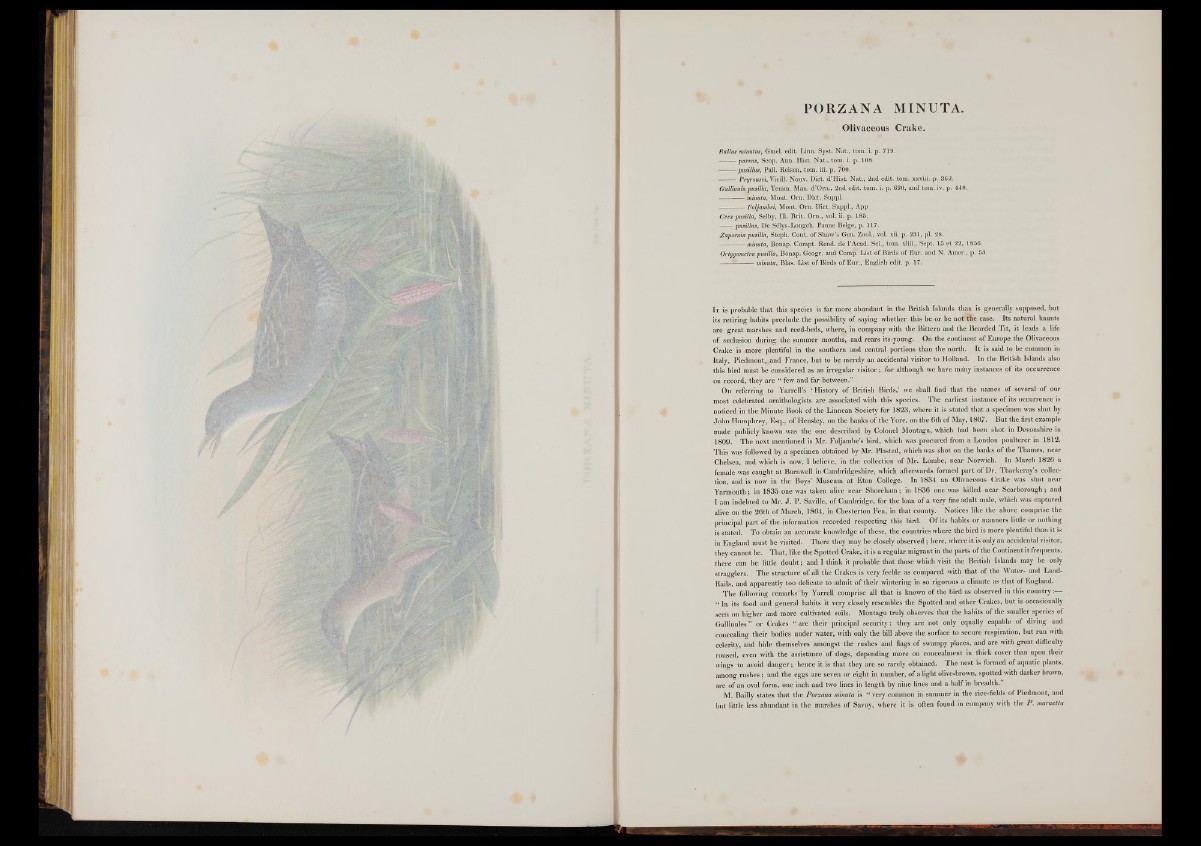
Olivaceous Crake.
Rallus minutus, Gmel. edit. Linn. Syst. Nat., tom. i. p. 719.
parvus, Scop. Ann. Hist. Nat., tom. i. p. 108.
pusillus, Pall. Reisen, tom. iii. p. 7&0.
Peyrousei, Vieill. Nouv. Diet. d’Hist. Nat., 2nd edit. tom. xxviii. p. 362.
Gallinula pusilla, Temm. Man. d’Orn., 2nd edit. tom. i. p. 690, and tom. iv. p. 440.
------------minuta, Mont. Orn. Diet. Suppl.
------------Foljambei, Mont. Orn. Diet. Suppl., App
Or ex pus ilia, Selby, 111. Brit. Orn., vol. ii. p. 185.
^ 5 — pusillus, De Selys-Longch. Faune Beige, p. 117.
Zapornia pusilla, Steph. Cont. of Shaw’s Gen. Zool., vol. xii. p. 231, pi. 28.
minuta, Bonap. Compt. Rend, de l’Acad. Sci., tom. xliii., Sept. 15 et 22, 1856.
Ortygometra pusilla, Bonap. Geogr. and Comp. List of Birds of Eur. and N. Amer., p. 53.
minuta, Bias. List of Birds of Eur., English edit. p. 17.
It is probable that this species is far more abundant in the British Islands than is generally supposed, but
its retiring habits preclude the possibility o f saying whether this be or be not the case. Its natural haunts
are great marshes and reed-beds, where, in company with the Bittern and the Bearded Tit, it leads a life
of seclusion during the summer months, and rears its*young. On the continent of Europe the Olivaceous
Crake is ■.more plentiful in the southern and central portions than the north. It is said to be common in
Italy, Piedmont,„and France, but to be merely an accidental visitor to Holland. In the British Islands also
this bird must be considered as an irregular v isito r; for although we have many instances of its occurrence
on record, they are “ few and far between.”
On referring to Yarrell’s ‘History o f British Birds,’ we shall find that the names of several o f our
most celebrated ornithologists are associated with this species. The earliest instance o f its occurrence is
noticed in the Minute Book of the Linnean Society for 1823, where it is stated that a specimen was shot by
John Humphrey, Esq., of Hensley, on the banks of the Yore, on the 6th o f May, 1807. But the first example
made publicly known was the one described by Colonel Montagu, which had been shot in Devonshire in
1809. The next mentioned is Mr. Foljambe’s bird, which was procured from a London poulterer in 1812.
This was followed by a specimen obtained by Mr. Plasted, which was shot on the banks o f the Thames, near
Chelsea, and which is now, I believe, in the collection o f Mr. Lombe, near Norwich. In March 1826 a
female was caught a t Barnwell in Cambridgeshire, which afterwards formed p art of Dr. Thackeray’s collection,
and is now in the Boys’ Museum at Eton College. In 1834 an Olivaceous Crake was shot near
Yarmouth; in 1835 one was taken alive near Shoreham; in 1836 one was killed near Scarborough; and
I am indebted to Mr. J . P. Saville, of Cambridge, for the loan o f a very fine adult male, which was captured
alive on the 26th of March, 1864, in Chesterton Fen, in that county. Notices like the above comprise the
principal part of the information recorded respecting this bird. O f its habits or manners little or nothing
is stated. To obtain an accurate knowledge of these, the countries where the bird is more plentiful than it is
in England must be visited. There they may be closely observed; here, where it is only an accidental visitor,
they cannot be. That, like the Spotted Crake, it is a regular m igrant in the p arts o f the Continent it frequents,
there can be little d o u b t; and I think it probable that those which visit the British Islands may be only
stragglers. The structure of all the Crakes is very feeble as compared with that of the Water- and Land-
Rails, and apparently too delicate to admit o f their wintering in so rigorous a climate as that of England.
The following remarks by Yarrell comprise all that is known o f the bird as observed in this country:
“ In its food and general habits it very closely resembles the Spotted and other Crakes, but is occasionally
seen on higher and more cultivated soils. Montagu truly observes that the habits of the smaller species of
Gallinules ” or Crakes “ are their principal security: they are not only equally capable o f diving and
concealing their bodies under water, with only the bill above the surface to secure respiration, but run with
celerity, and hide themselves amongst the rushes and flags of swampy places, and are with great difficulty
roused, even with the assistance o f dogs, depending more on concealment in thick cover than upon their
wings to avoid dan g er; hence it is that they are so rarely obtained. The nest is formed o f aquatic plants,
among ru sh e s; and the eggs are seven o r eight in number, of a light olive-brown, spotted with darker brown,
are of an oval form, one inch and two lines in length by nine lines and a half in breadth.”
M. Bailly states that the Porzana minuta is “ very common in summer in the rice-fields of Piedmont, and
but little less abundant in the marshes o f Savoy, where it is often found in company with the P . maruetta